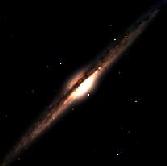 |
||
| First page | ||
 |
||
| Milky way | ||
 |
||
| Spiral galaxies | ||
 |
||
| Elliptical galaxies | ||
 |
||
| Irregular galaxies | ||
 |
Quasars | |
 |
||
| Find out more | ||
 |
||
 |
||
 About half of all galaxies are spiral galaxis and apart for our own galaxy, the Milky way, the spiral galaxy closest to us is Andromeda which is 2 million light-years away. Andromeda is very similar in size and structure to the Milky Way galaxy, and they are both very typical large, and massive, spiral galaxies. A typical giant spiral galaxy includes at least 100 billion stars in its diameter of 100,000 light years.
About half of all galaxies are spiral galaxis and apart for our own galaxy, the Milky way, the spiral galaxy closest to us is Andromeda which is 2 million light-years away. Andromeda is very similar in size and structure to the Milky Way galaxy, and they are both very typical large, and massive, spiral galaxies. A typical giant spiral galaxy includes at least 100 billion stars in its diameter of 100,000 light years.
The image to the left, of NGC 4565, shows what a spiral galaxy looks like in profile.
Like the Milky way galaxy a spiral consists of a nucleus, a disk, a halo of mainly dark matter and spiral arms. There are two extremes of the way a spiral galaxy can look; it may have a large and luminous bulge and faint arms or a small bulge, almost none, and loosely wound arms. Both Milky way and Andromeda are intermediate between the two extremes.
 The picture to the left shows the Whirlpool Galaxy (the Messier 51) seen face on with respect to us. This galaxy has also a baby galaxy attached to it (top).
The picture to the left shows the Whirlpool Galaxy (the Messier 51) seen face on with respect to us. This galaxy has also a baby galaxy attached to it (top).
Spiral galaxies are the birthplace of most of the stars in the universe. The spiral arms are the home of young stars and supergiants. A third of the spiral galaxies have a bar running through their nuclei, the arms then usually begin from the ends of the bar (instead of directly from the nucleus). All spirals and barred spirals rotate in the sense that their arms trail. Some astronomers believe that almost all spiral galaxies contain at least a weak bar, but the structure of barred spirals are just beginning to be understood.
26th July 2000
Sarah Amandusson
www_astro@mssl.ucl.ac.uk